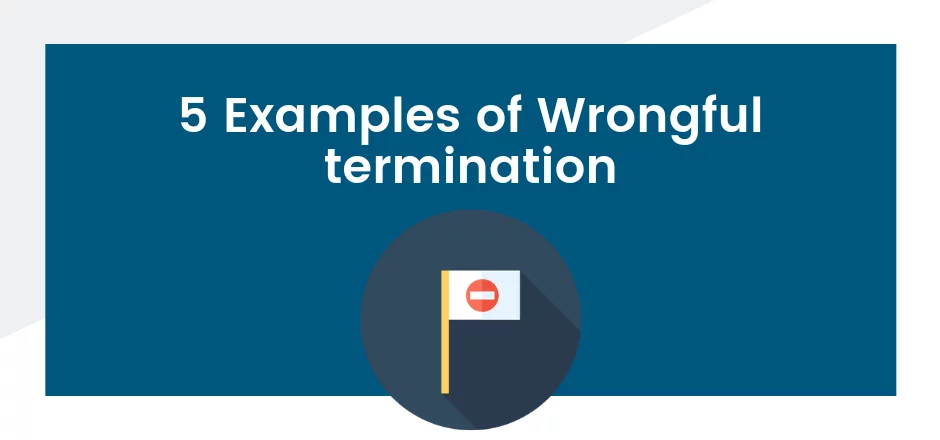Examples of Wrongful termination: 5 Reasons to File A Claim
The state of California protects employees from a variety of discrimination and other wrong-doing, including wrongful termination. So, what is wrongful termination exactly and what can you do about it?
Today, we’re taking a closer look at five examples of wrongful termination so you’re prepared.
Examples of Wrongful Termination
Employees and employers alike are often in the dark as to what constitutes wrongful termination. An employer who fires an employee without regard to termination laws leaves himself open to strong legal action.
An employee who doesn’t know his or her rights in the workplace can lose an opportunity to file a legal complaint along with any chance of compensation for being fired illegally.
So how do you know if you are wrongfully terminated?
Here is some basic information that will help you understand the employment laws regarding the subject.
At will employment
At will employment means you can quit or be terminated at any time and without cause. However, there are certain conditions that might still apply for wrongful termination. If the employer terminates the employee because of discrimination or retaliation, there is a case for illegal termination.
“Good faith and fair dealing” is a principle which applies to all contracts, whether stated or implied. Some terminations may be a breach of this contract principle and subject to an illegal termination claim. Forcing employees to quit without collecting sales commissions, severance pay or other benefits may also be breaches of contract.
There is another scenario during “at will” employment, or even contractual employment, where an employee decides to resign because of unacceptable working conditions. The reason could be that the job is unsafe or unhealthy. Working conditions have become intolerable.
This situation is called “Constructive Dismissal.”
Constructive Dismissal
Constructive dismissal results from an employee quitting but in an involuntary way because the employer’s working conditions really violated the express or implied contract. The resignation is really treated as firing in this case.
There are conditions which must be met for the situation to meet requirements for constructive dismissal. For example, in California, the employee must prove that the conditions were so bad that any reasonable person would have felt compelled to quit. The second condition is that the employer knew the conditions were intolerable or he intended to force the resignation of the employee.
Generally, a single negative occurrence is not enough to warrant a judgment of constructive dismissal. More often than not, it is the pattern of adverse conditions that can lead to such a judgment.
Contractual employment
If you signed a contract or entered into a verbal agreement with your employer, then that employer is obligated to honor the agreement, written or not. A verbal promise becomes an implied contract. If for example, your employer tells you he will give you six months to prove yourself and then lets you go after three months, he is breaching the implied contract.
Unfair labor practices may include misleading or deceiving employees about their chances for raises or promotions. It is also wrong for employers to lie about the reason to replace someone when the real reason was to replace that person with cheaper labor. It is wrong for an employer to transfer an employee or reassign him or her to avoid paying a sale commission.
Whistleblower retaliation
If you are fired after you report an unethical or illegal act by your employer, he may be guilty of whistleblower retaliation. The same would be true if you reported wasteful spending or other actions that led to a retaliatory termination. Different states have different regulations, however, so you should check with your own state for guidance.
Illegal act retaliation
You cannot be legally terminated if you refused to perform an illegal act, for example, or work unpaid hours or double shifts in violation of labor laws. In such cases, you may be able to make a claim for retaliatory termination.
Classes protected from discrimination
Anti-discrimination laws prevent employers from taking adverse action against any employee considered to be in a protected class if that action is based on a protected characteristic. Adverse action includes termination. Protected characteristics include race, color, religion, age, gender, pregnancy or disability.
Some states have other protected categories including sexual orientation, immigration status, and gender identity. Anti-discrimination laws protect all these classes of employees from targeted termination based solely or predominantly on protected characteristics.
Protected time off
There are certain times and situations that allow time off from work, and during these times employees are protected from being terminated. For example, the Family and Medical Leave Act allows employees to recover from illness or care for a family member. The Act also covers time to serve on a jury or go to vote. Military service members who are called to duty may not be terminated for this reason.
In California and possibly other states, protected time off includes taking time for medical treatment or legal proceedings in cases of domestic violence, sexual assault or stalking. Employers should explain these rights to their employees.
Disciplinary steps
Many companies have a published set of rules covering possible disciplinary policies. Often these rules are in an employee handbook or in a set of Human Resources documents. Once an employer publishes or discusses these policies with employees, the employer is bound to follow them.
If the policy says that an employee shall have two warnings before being terminated, then if that employee is fired after one warning, there may be a case for wrongful termination. If the employee was told he would get a written warning but did not, and was terminated, there may be another case. In the case of formal disciplinary guidelines, both sides should follow them.
Filing a discrimination claim
An employee who feels he or she was terminated because of discrimination can file a complaint (also called a charge) with the federal agency, Equal Employment Opportunity Commission (EEOC). This agency handles most of the legal claims made in discrimination cases.
Employees can file a complaint against their employers only after they appeal to the EEOC and are granted a Notice of Right to Sue.
Penalties can be heavy
There are monetary penalties that may be determined as well as possible punitive damages depending on the motive of the employer or reckless disregard for the protected rights of employees.
Settlements for wrongful termination can cover attorney fees and lost wages as well as punitive damages that can total several hundred thousand dollars. The average out-of-court settlement is $40,000. Ten percent of wrongful termination cases, including discriminations, reach a settlement figure of $1 million.
If you feel you have been wrongfully terminated, you should consult an attorney to get the best advice on how to proceed with filing a claim including learning about federal and state laws as they apply to your situation.
Are you in search for a certified attorney to represent you?
Let us help you find one today!


I think my employer has wrongfully terminated me when I got pregnant. He may have discriminated against me because he expects me to file for maternal leave. Since you said this could be an example of illegal termination, I’ll hire a labor law service to help me file a claim.